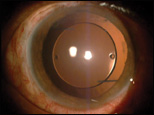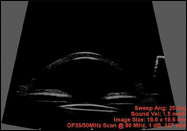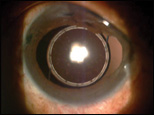Tilt is negligible with glued IOL
Analyses with AS-OCT and UBM showed no differences in visual acuity in glued IOL eyes with and without tilt.
Ten years after the development of the glued IOL technique, expectations and prospects are high. Along with newer instrumentation techniques and clinical examination methodologies, surgeons are motivated to learn the intricacies that can lead to good optical quality vision. Glued lens involves the transscleral attachment of the IOL into the scleral tunnel or pockets under the standard flaps, as seen in Figure 1. IOL tilt is the anatomical shift in the axis of the IOL in situ in relation to the iris plane or limbus. It is well known that any tilted IOL can induce visual blur and therefore hinder patient satisfaction. Hence, a satisfied patient is the final goal for any surgical intervention.
IOL tilt measurement

Source: Dhivya Ashok Kumar, MD, FRCS, FICO, FAICO, and Amar Agarwal, MS, FRCS, FRCOphth


IOL tilt (Figure 2) can be measured objectively by standard methods such as ultrasound biomicroscopy (UBM). Anterior segment OCT (AS-OCT) is an additional modality that can be performed without contact and in less time. Unlike UBM, it does not require contact fluid and has a shorter learning curve. Due to its noninvasive nature, OCT is preferred in early postoperative patients. An AS-OCT high-resolution raw image of the IOL can be taken, and the axis along the IOL (L) is marked (Figure 3). The reference line can be the line across the iris plane (I), and the angle between the IOL and the iris (L and I) measured. In UBM, one can use either the iris plane or limbus for assessment of tilt.
Negligible tilt
Glued IOL showed minimal postoperative tilt in an earlier reported study (Figure 4). In our AS-OCT analysis, out of 60 glued IOLs, 21 eyes (35%) showed optic tilt while 39 eyes (65%) did not show any optic tilt (Figure 5) in the postoperative period. The mean angle measured between the IOL and the iris was noted to be 3.2° ± 2.7° on the horizontal axis and 2.9° ± 2.6° on the vertical axis. No association was noted between the IOL tilt and best corrected visual acuity. Further, the IOL position was not dependent on the type of lens, age of the patient or the surgical indications. There was no difference in BCVA between the eyes with and without optic tilt. The study also quantified the mean total astigmatism to be 1.9 ± 1.3 D; the mean total cylinder in the non-foldable and the foldable IOL group was 2 ± 1.1 D and 1.6 ± 1.7 D, respectively. In our in vivo UBM study of 46 eyes, eight eyes (17.4%) showed optic tilt and 38 eyes (82.6%) showed no optic tilt. There was no significant difference in uncorrected distance visual acuity or BCVA between the eyes with tilt and the eyes without tilt.


ORA and glued IOL
Our study reported the mean ocular residual astigmatism (ORA) as 0.53 ± 0.5 D. There was a significant correlation between ORA and total astigmatism. However, there was no association between ORA and optic tilt, and also there was no difference observed in ORA between the eyes with and without optic tilt. The in vivo UBM study by Kumar and colleagues with a short-term follow-up of 24.6 ± 14.3 months showed the mean ORA as 0.5 ± 0.2 D. There was no significant difference in ORA between eyes with optic tilt and eyes without optic tilt on UBM.
Significance of IOL position
With glued IOLs, there is no anchoring of haptics with sutures; hence, there should not be optic tilt from suture-related problems. Moreover, in glued transscleral-fixated IOL, the haptics are directly tucked inside the intralamellar scleral tunnel, which has been known to provide successful postoperative surgical adhesion. In a glued IOL, the entire IOL is embraced along the curvature of the eye, unlike a suture-fixated IOL in which the suture haptic junction holds the fulcrum of action. Hence, ocular movements and endophthalmodonesis are expected to have less effect on a glued IOL compared with a sutured IOL. Although there was detectable microscopic tilt in 35% of eyes, it was less than the microscopic tilt seen in sutured scleral-fixated IOLs.
Conclusion
Anchoring a longer part of the haptic stabilizes the axial position of the posterior chamber IOL, leading to a decrease in the incidence of IOL tilt. Direct visualization of the port site and haptic externalization are additional factors for less postoperative tilt in glued lenses.
- References:
- Kumar DA, et al. J Cataract Refract Surg. 2013;doi:10.1016/j.jcrs.2013.01.039.
- Kumar DA, et al. Ophthalmology. 2015;doi:10.1016/j.ophtha.2014.07.032.
- For more information:
- Amar Agarwal, MS, FRCS, FRCOphth, is director of Dr. Agarwal’s Eye Hospital and Eye Research Centre. Agarwal is the author of several books published by SLACK Incorporated, publisher of Ocular Surgery News, including Phaco Nightmares: Conquering Cataract Catastrophes, Bimanual Phaco: Mastering the Phakonit/MICS Technique, Dry Eye: A Practical Guide to Ocular Surface Disorders and Stem Cell Surgery and Presbyopia: A Surgical Textbook. He can be reached at 19 Cathedral Road, Chennai 600 086, India; email: dragarwal@vsnl.com; website: www.dragarwal.com.
- Dhivya Ashok Kumar, MD, FRCS, FICO, FAICO, is senior consultant and head of R&D at Dr. Agarwal’s Eye Hospital and Eye Research Centre. She can be reached at 19 Cathedral Road, Chennai, India; email: susruta2002@gmail.com.
Disclosures: Agarwal reports he is a paid consultant for Staar Surgical. Kumar reports no relevant financial disclosures.
